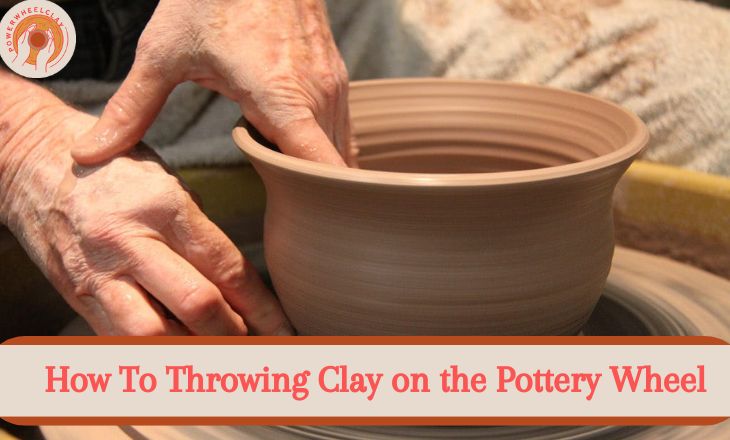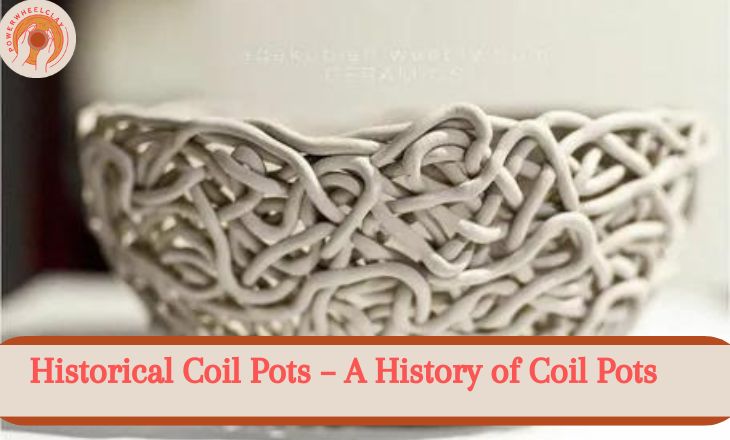How To Throwing Clay on the Pottery Wheel: A Step-by-Step Beginners Guide
As a beginner in the world of ceramics, I was equally fascinated and intimidated by the idea of throwing clay on the pottery wheel.
But let me tell you, once I got my hands dirty and started spinning that wheel, there was no turning back! In this step-by-step guide, I will walk you through the magical process of transforming a lump of clay into a work of art.
So grab your apron, get ready to dive in headfirst (literally), and let’s embark on this exciting journey together as we learn how to throw pottery on the pottery wheel.
What is Wheel-throwing
Wheel throwing is a pottery technique where clay is shaped on a spinning wheel to create various forms such as bowls, cups, and vases. This hands-on process requires skill and precision to control the speed and pressure applied to the clay. Artists use their fingertips and tools to shape the clay into symmetrical and balanced pieces.
One of the most appealing aspects of wheel-throwing ceramics is the sense of meditative focus it provides. As potters centre their clay on the spinning wheel, they enter a state of concentration that requires patience and mindfulness.
The rhythmic motion of shaping the clay becomes almost therapeutic, allowing artists to escape from distractions and fully immerse themselves in their creative process. Wheel throwing offers endless possibilities for artistic expression through its versatility in form and texture. Each piece created on the pottery wheel is unique, showcasing the artist’s style and vision.
From functional pottery to sculptural pieces, wheel throwing allows artists to explore different techniques and experiment with new ideas, making it a fascinating journey in artistic exploration. Following are the wheel-throwing steps.
What to Wear When Throwing on the Pottery Wheel
When you’re gearing up to throw on the pottery wheel, comfort and practicality are key. Opt for clothing that allows for ease of movement and won’t restrict your arms as you work with the clay. Choose fitted tops or shirts that can be easily tucked in to prevent them from getting in the way.
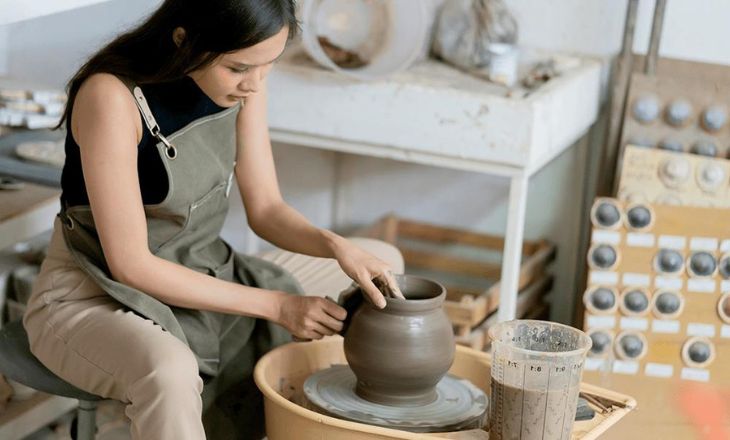
Avoid wearing long, loose sleeves or flowing scarves that could potentially get caught in the spinning wheel. Consider wearing an apron or smock to protect your clothes from any splashes of clay or water.
When it comes to footwear, closed-toe shoes are a must to ensure safety while operating the pottery wheel. Finding the right balance between form and function will not only keep you comfortable but also allow you to fully immerse yourself in the creative process of throwing pottery.
Tools and Supplies Needed to Throw Clay on the Pottery Wheel
When it comes to throwing clay on the pottery wheel, having the right tools and supplies is essential for a successful and enjoyable experience. Some key items you will need include a pottery wheel, clay, water bucket, sponge, needle tool or trimming tool, wire tool, ribs for shaping the clay, and a kiln for firing your finished pieces.
Pottery Wheel
PotteryWheel is a revolutionary product that has taken the art of pottery-making to new heights. With its innovative CXC technology, this pottery wheel offers unparalleled precision and control, allowing artists to create stunning pieces with ease.
What sets PotteryWheel apart from traditional wheels is its ability to seamlessly blend traditional craftsmanship with modern technology, giving potters the best of both worlds. One of the key advantages of PotteryWheel is its versatility.
Whether you are a beginner just starting or an experienced artist looking to take your craft to the next level, this pottery wheel caters to all skill levels. The intuitive design and user-friendly interface make it easy for anyone to learn and master the art of pottery-making.
With PotteryWheel, the possibilities are endless, as you can explore different techniques and styles to unleash your creativity like never before.
Pottery Tools
Pottery tools are key elements in the creative process of moulding clay into beautiful works of art. The 8-Piece Pottery Tool Set is a must-have for both beginners and experienced potters, offering a wide range of tools to help bring artistic visions to life.
From shaping and smoothing tools to detailing and carving tools, this set provides versatility and precision in creating unique pottery pieces. One fascinating aspect of pottery tools is their ability to transform a simple lump of clay into intricate designs through the skilled hands of the potter.
Each tool serves a specific purpose, allowing the artist to express their creativity and craftsmanship in different ways. Whether it’s creating textures, patterns, or fine details, pottery tools play a vital role in shaping the outcome of a piece.
Choosing Your Clay for Throwing on the Pottery Wheel
One of the key factors in successful pottery throwing on a wheel is selecting the right type of clay. Porcelain clay offers a smooth texture and is excellent for intricate designs, while stoneware clay provides durability and versatility in various forms.
Earthenware clay has a lower firing temperature, making it ideal for beginners experimenting with different techniques. Each type of clay has its unique properties that will affect your finished piece. Consider the plasticity, colour, and firing range of the clay to achieve the desired results.
Experimenting with different types of clays can help you discover new possibilities and enhance your pottery skills. Choosing the right clay is essential in creating pottery that matches your vision and style.
Prepare Your Clay for the Pottery Wheel
Preparing your clay for the pottery wheel is crucial for a successful throwing session. Begin by wedging your clay to ensure uniform consistency and remove air bubbles that could cause your piece to crack during firing.
Pay attention to the moisture content of your clay; too dry, and it will be difficult to work with, too wet, and it may collapse on the wheel. Take the time to knead and massage the clay until it feels pliable and ready for shaping.
Wedging
Wedging is a crucial technique in pottery that involves kneading and pressing clay to remove air bubbles and ensure uniform consistency. This process not only improves the workability of the clay but also enhances its strength and durability.
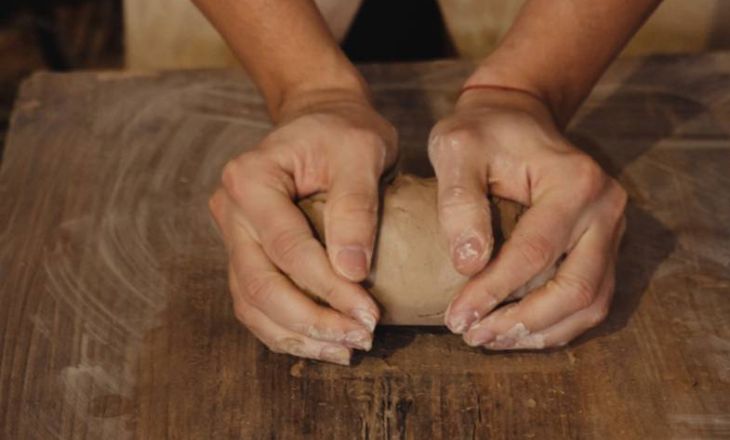
By carefully wedging the clay, potters can prevent cracking or warping during the drying and firing stages of the pottery-making process. One interesting aspect of wedging is that it allows potters to incorporate different colours or textures into their clay by layering or marbling different clays together.
This technique adds a unique visual element to the finished piece, creating a dynamic and eye-catching design. Wedging can be a meditative and calming practice for potters, as it requires focus and precision to properly prepare the clay for shaping.
Weighing
The weighing of clay is a crucial step in pottery making that requires precision and care. By accurately measuring the amount of clay needed for a project, potters ensure uniformity in their creations and avoid wastage.
Different types of clays have unique weights and properties, leading to varying results in the final piece. Weighing clay also plays a significant role in achieving consistency in pottery production.
Potters often rely on digital scales to measure exact amounts of clay, allowing them to reproduce pieces with identical dimensions. This process not only enhances efficiency but also promotes quality control within the pottery studio.
Get Familiar with Your Position at Pottery Wheel
Understanding your position at the pottery wheel is crucial for creating beautiful and balanced pieces. Your body posture and hand placement play a significant role in determining the outcome of your creation.
By sitting upright with your shoulders relaxed and elbows close to your body, you can maintain control over the clay as it spins on the wheel. It’s important to find a comfortable stance that allows you to lean into the wheel without straining your back or neck.
Experiment with different hand positions and pressures to discover what works best for you.
Centering on the Pottery Wheel
As you spin the pottery wheel, a sense of tranquillity envelops you, guiding your hands to mould clay into beautiful forms. The rhythmic rotation of the wheel mirrors the cyclical nature of creation, reminding us of the constant evolution and transformation in art and life.
Each movement on the wheel is deliberate yet unpredictable as if dancing in harmony with the untamed potential of the clay. Centering on the pottery wheel requires not just technical precision but also an emotional connection to your craft.

It’s about finding a balance between control and surrender, allowing yourself to be guided by intuition while honing your skills through practice and patience. In this meditative process, time slows down, and you become fully present in a state of flow where creativity flourishes effortlessly.
Coming Up The Clay
As pottery enthusiasts know, the process of coming up with the clay is a crucial step in preparing clay for throwing on the wheel. This technique involves repeatedly lifting and slamming a ball of clay onto the centre of the wheel to eliminate air bubbles and create a more consistent texture.
By pushing the clay upwards in a conical shape, potters can centre the clay effectively before shaping it into their desired form. With each rotation and compression, the clay becomes more pliable and ready for moulding, ensuring a smooth and structured creation.
Ultimately, coming up with the clay is not just about preparation—it’s about establishing a connection that sets the stage for limitless creative expression in pottery making.
Press Down The Clay To Center
Pressing down the clay to the centre is a fundamental technique in pottery that requires a delicate balance of pressure and precision. This process helps to create a strong foundation for shaping and moulding the clay into various forms, ensuring that the piece remains balanced and properly aligned.
As the potter applies downward pressure with steady hands, the clay gradually begins to take shape and centre itself on the wheel. One important aspect of pressing down the clay to the centre is maintaining patience and focus throughout the process.
It requires careful attention to detail and a gentle touch to ensure that the clay moves smoothly without becoming misshapen or off-centre. By mastering this technique, potters can achieve symmetry and balance in their creations, resulting in beautifully crafted pieces that showcase their skill and artistry.
Opening your Clay on the Pottery Wheel
When opening your clay on the pottery wheel, it’s crucial to find the right balance between pressure and precision. Start by centring your clay perfectly before gently pressing down with your thumbs to create an even indentation in the middle.
The key is to gradually widen this indentation while keeping a firm grip on the outer walls to maintain stability. As you begin stretching and shaping the clay, pay attention to its response to subtle changes in pressure and speed.
Remember that each type of clay has its unique properties, so don’t be afraid to experiment and adjust your technique accordingly. Embrace the process of opening your clay as a dynamic dialogue between yourself and the material, allowing room for spontaneity and creative exploration.
Check The Thickness of The Clay
The thickness of the clay can greatly impact the overall strength and durability of the finished piece. It’s important to carefully consider the intended use of the object being created when determining how thick or thin to make the clay walls.
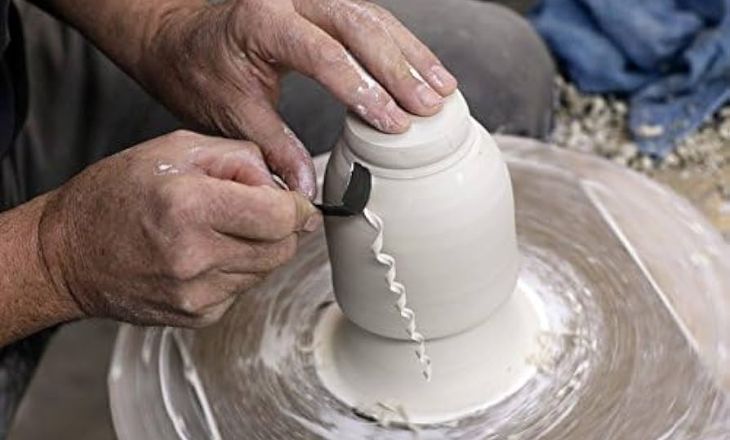
Thin walls can result in fragile, delicate pieces that may be more prone to breaking or cracking. On the other hand, thicker walls can provide additional stability and strength, making the piece more durable over time.
Experimenting with different thicknesses of clay can lead to a deeper understanding of how this element impacts the outcome of a pottery project. Understanding and mastering control over clay thickness allows for greater versatility in creating unique and stunning ceramic pieces that stand out from the rest.
Form the Base of the Clay on the Pottery Wheel
In pottery making, forming the base of the clay on the pottery wheel is a crucial step that sets the foundation for the entire piece. The base not only provides stability but also determines the overall shape and balance of the object being created.
Starting with a well-centred mound of clay, potters skillfully apply pressure from their hands to gradually shape and compress the clay into a stable base. This process requires patience and precision as any unevenness or weakness in this initial stage can greatly impact the outcome.
One key technique used in forming the base is known as opening up, where potters create a depression in the centre of the clay mound using their thumbs to begin shaping the vessel. By slowly widening and refining this depression, potters establish a strong foundation.
The base not only serves a functional purpose but also contributes to the aesthetic appeal of the finished piece, highlighting craftsmanship and attention to detail.
Pulling up the Walls of your Clay on the Pottery Wheel
When it comes to working with clay on the pottery wheel, one of the most crucial skills to master is pulling up the walls. This technique requires a delicate balance of pressure and speed, as too much force can cause the clay to collapse while too little will result in uneven walls.
As you pull up the walls of your clay vessel, it’s important to maintain a steady rhythm and consistent hand movements. By paying attention to how thin or thick the walls are becoming, you can ensure that your finished piece is not only visually appealing but also functional.
Remove the Water
Removing the water element can drastically alter the landscape and ecosystem of a region. Without water, plants struggle to survive, leading to desertification and loss of biodiversity. This process is not just limited to natural causes but is increasingly influenced by human activities such as deforestation and industrialization.
One of the most crucial consequences of removing water is the impact on local communities and economies. Agriculture, fishing, tourism, and other industries relying on water sources can suffer greatly when water is depleted or contaminated.
It’s essential to recognize that removing the water element doesn’t just affect individual regions but can have widespread global implications.
Climate change exacerbates these issues as changing weather patterns lead to more frequent droughts and floods. Finding innovative solutions that balance development with conservation becomes more urgent in ensuring a sustainable future for all beings on Earth.
Colour in The Clay
Colour in the clay refers to the subtle variations of colour found in different types of clay soil, which can greatly influence the outcome of pottery and ceramics. These variations are caused by factors such as mineral content, organic matter, and environmental conditions.
For example, red clay is often rich in iron oxide, giving it a warm reddish hue, while white clay may contain higher levels of kaolin and have a lighter appearance. Artists and potters often leverage the unique colours of different clays to create visually striking pieces that showcase the natural beauty of the material.
By carefully selecting and blending clays with varying colours, textures, and properties, creators can achieve stunning effects in their work. the firing process can further enhance these colour variations, resulting in intricate patterns and designs that add depth and character to ceramic pieces.
Apply Even Pressure
To achieve the best results when applying pressure, it is essential to maintain a consistent and even force throughout the task. By distributing pressure evenly, you ensure that all areas receive adequate attention and avoid creating uneven surfaces or causing damage.
This approach not only improves the outcome but also reduces the risk of fatigue or strain on your muscles when applying even pressure, it is helpful to focus on your body mechanics and posture. Maintaining proper alignment can enhance your control and precision, leading to more effective results. Practising mindfulness and being present at the moment can help you stay attuned to how much force you are exerting, preventing accidents or mistakes.
Mastering the art of applying even pressure takes practice and patience but can significantly elevate your skills in various tasks requiring finesse and attention to detail.
Compress The Rim
Compress The Rim is a revolutionary new technology in the world of basketball that aims to enhance players’ shooting skills. By compressing the size of the rim, this innovative system challenges players to improve their accuracy and precision when taking shots.
This unique training tool provides a competitive edge for athletes looking to elevate their game to the next level. Players who utilize Compress The Rim experience increased focus and attention to detail while shooting, as they must be more exact in their aim to make successful baskets.
The reduced size of the rim forces players to fine-tune their techniques and develop better muscle memory, leading to improved performance on the court.
Add Water to The Clay
Adding water to clay is a transformative process that unlocks its potential for shaping and moulding. The moisture revitalizes the clay, making it pliable and responsive to the artist’s touch. By adding just the right amount of water, one can achieve the perfect consistency for sculpting intricate details or forming larger structures with ease.
The addition of water not only enhances workability but also allows for greater creativity and experimentation in clay art. The fluidity that water brings to the clay enables artists to explore different techniques, textures, and shapes that may not be achievable with dry clay alone. Adding water to clay opens up a world of possibilities and endless artistic expression waiting to be realized through skilled hands and creative minds.
Finishing your Cylinder On the Pottery Wheel
After hours of careful shaping and refining on the pottery wheel, you may reach a crucial point where it’s time to finish your cylinder. This final step requires precision and patience to ensure a smooth and uniform surface.
Begin by gently compressing the rim with your fingertips, and gradually widening it to achieve the desired shape. Pay close attention to the walls, applying even pressure as you lift and shape the clay.
As you approach the finishing touches, be mindful of maintaining consistency in thickness throughout the cylinder. Use tools such as a rib or chamois to refine any imperfections and create a polished appearance.
By focusing on detail and embracing imperfections as part of the artistic process, you’ll elevate your pottery skills and create a truly stunning finished piece.
Trust in your instincts, experiment with different techniques, and most importantly, enjoy every moment of this creative journey towards mastering pottery craftsmanship.
Compress and Remove the Water
In the world of water treatment and purification, one key process that often goes unnoticed is the compression and removal of water. This crucial step involves reducing the volume of water through advanced technologies like reverse osmosis or evaporation, resulting in clean and drinkable water.
By compressing the water, impurities are separated, leaving behind a more concentrated solution that can be further treated. Removing excess water plays a significant role in ensuring efficiency and sustainability in various industries such as agriculture, pharmaceuticals, and manufacturing.
Water compression also aids in reducing transportation costs by making it easier to move large amounts of purified water over long distances. This process helps in minimizing environmental impact by decreasing the amount of wastewater produced during purification processes.
Remove The Slip From the Outside of The Cylinder
When it comes to cylinder maintenance, one crucial step is removing the slip from the outside of the cylinder. This step is essential to ensure the proper functioning and safety of the cylinder. The slip, usually made of paper or plastic, is used during manufacturing to protect the cylinder surface. It can pose a risk if not removed before using the cylinder.
Removing the slip requires careful attention and precision to avoid damaging the cylinder surface. A common method is using a utility knife or blade to carefully cut along the edges of the slip and peel it off gently.
It’s important to inspect the entire surface for any remaining bits of slip that could cause issues down the line. By ensuring that you remove the slip from the outside of the cylinder before use, you are taking an important step in maintaining your equipment’s longevity and performance.
Form The Base of The Cylinder
When it comes to discussing the foundation of a cylinder, one must first understand the crucial role that the base plays in shaping its overall structure. The base of a cylinder serves as the primary anchor point, providing stability and support for the entire shape.
Without a solid base, the cylinder would be unable to stand upright or maintain its cylindrical form. The base of a cylinder also determines its surface area and capacity.
The size and shape of the base directly impact these measurements, making it essential to consider when designing or analyzing cylinders for various applications.
By manipulating the dimensions of the base, one can significantly alter the properties and functions of a cylinder, showcasing the versatility and adaptability of this fundamental geometric shape.
Compress and Smooth Out the Rim
When it comes to discussing the foundation of a cylinder, one must first understand the crucial role that the base plays in shaping its overall structure. The base of a cylinder serves as the primary anchor point, providing stability and support for the entire shape.
Without a solid base, the cylinder would be unable to stand upright or maintain its cylindrical form. The base of a cylinder also determines its surface area and capacity. The size and shape of the base directly impact these measurements, making it essential to consider when designing or analyzing cylinders for various applications.
By manipulating the dimensions of the base, one can significantly alter the properties and functions of a cylinder, showcasing the versatility and adaptability of this fundamental geometric shape.
Removing your Cylinder from the Pottery Wheel
When it comes to pottery, one essential but often overlooked task is removing the cylinder from the pottery wheel. As you reach this stage in the process, it’s crucial to handle the cylinder with care and precision to avoid any mishaps.
Gently lift the cylinder off the wheel by supporting it from underneath as you slide your hands towards its centre. Ensure that your movements are smooth and controlled to prevent any distortion of the shape you’ve meticulously crafted.
To avoid damaging your work at this critical point, consider using a wire tool or a cutting wire specifically designed for this purpose. By carefully slicing through the clay where it meets the wheel head, you can cleanly detach your cylinder without disrupting its form.
Conclusion
Throwing clay on the pottery wheel is a skill that requires practice, patience, and dedication. By following the step-by-step guide provided in this article, beginners can learn the basics of ceramic art and develop their unique style.
Remember to keep your hands steady, maintain proper posture, and focus on centring the clay to create balanced forms. With time and experience, you will gain confidence in your abilities and be able to create beautiful pieces of pottery. So, grab some clay, hop on the wheel, and let your creativity flow!
FAQS
What is The Easiest Thing to Throw on a Pottery Wheel?
Small Ceramic bowls are some of the easiest things to start throwing as a beginner potter.
What Pottery Technique a Beginner Should Start With?
A beginner should start learning pottery with any basic making technique, these include pinching, slabbing, coiling or wheel throwing.
